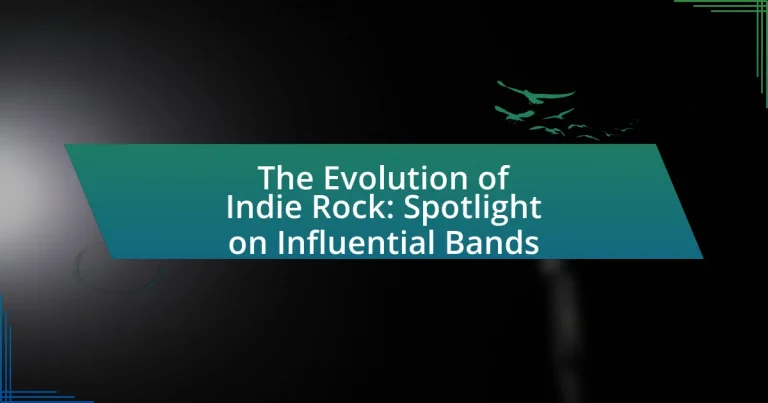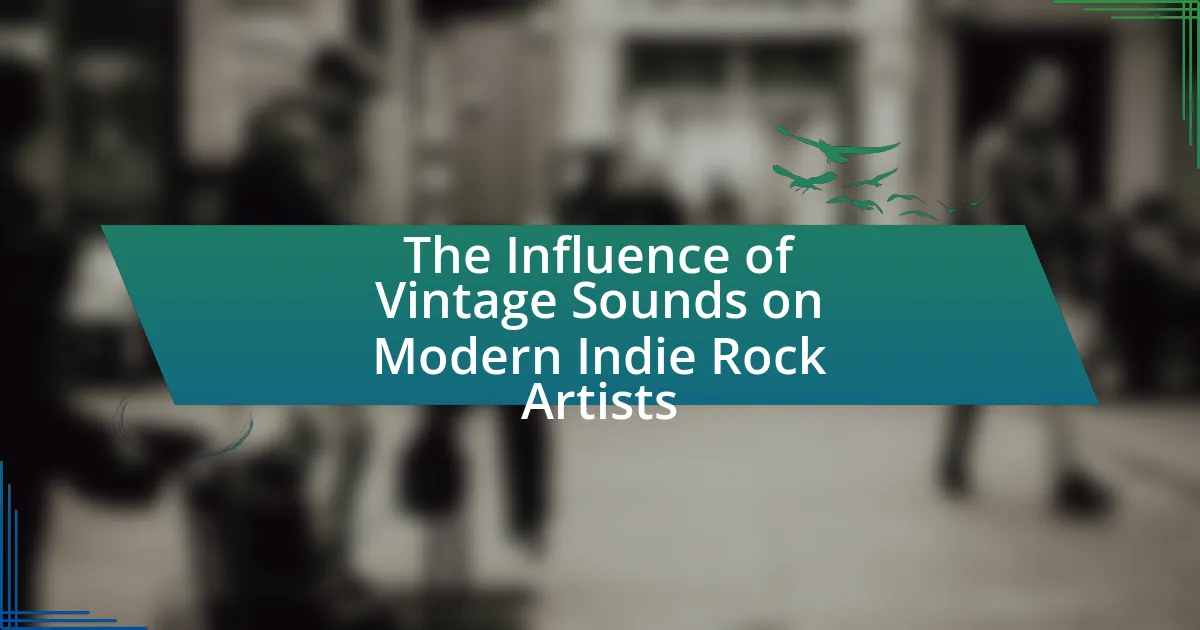Indie rock is a genre of alternative rock music that originated in the 1980s, marked by its independent production and distribution outside major record labels. The article explores the evolution of indie rock, highlighting influential bands such as R.E.M., The Smiths, and Radiohead, and their contributions to the genre’s sound and ethos. It examines the defining characteristics of indie rock, including its DIY culture, artistic integrity, and the impact of the internet on music distribution. Additionally, the article discusses the challenges faced by contemporary indie rock artists and the strategies they can employ to thrive in a competitive market.

What is Indie Rock and How Did It Evolve?
Indie rock is a genre of alternative rock music that emerged in the 1980s, characterized by its independent production and distribution, often outside of major record labels. The evolution of indie rock began with bands like R.E.M. and The Smiths, who gained popularity through college radio and independent labels, setting the stage for a diverse range of sounds and styles. In the 1990s, the genre expanded with the rise of bands such as Pavement and Neutral Milk Hotel, who further defined the sound with lo-fi production and eclectic influences. The 2000s saw a surge in popularity for indie rock, with bands like The Strokes and Arcade Fire achieving mainstream success while maintaining their independent ethos. This evolution reflects a continuous blending of musical influences and a commitment to artistic integrity, making indie rock a significant force in the music industry.
What are the defining characteristics of Indie Rock?
Indie Rock is characterized by its independent production and distribution, often eschewing major record labels. This genre typically features a diverse range of sounds, blending elements from various musical styles, including punk, folk, and electronic. Additionally, Indie Rock artists often prioritize artistic expression over commercial success, leading to a more experimental approach in songwriting and instrumentation. The genre is also known for its DIY ethic, where musicians often self-produce their music and promote it through grassroots channels. Historically, bands like R.E.M. and The Smiths have exemplified these traits, influencing the genre’s development and popularity.
How do these characteristics differentiate Indie Rock from mainstream genres?
Indie Rock is differentiated from mainstream genres primarily through its emphasis on artistic freedom, DIY ethics, and a focus on unique sound over commercial appeal. Unlike mainstream genres, which often prioritize mass-marketability and radio-friendly formats, Indie Rock artists typically produce music that reflects personal expression and experimentation. For instance, bands like Radiohead and Arcade Fire have gained recognition for their innovative approaches and willingness to explore unconventional themes and sounds, which contrasts sharply with the formulaic structures often found in mainstream pop and rock music. This distinction is further supported by the independent nature of many Indie Rock labels, which allows for greater creative control and less commercial pressure compared to major record labels that dominate mainstream music.
What role does DIY culture play in the Indie Rock scene?
DIY culture is fundamental to the Indie Rock scene as it empowers artists to create, produce, and distribute their music independently. This autonomy allows musicians to maintain creative control and authenticity, which are core values of the Indie Rock ethos. Historically, bands like Sonic Youth and Fugazi exemplified this by self-releasing albums and organizing their own tours, fostering a community-oriented approach that prioritizes artistic integrity over commercial success. The rise of digital platforms further supports this culture, enabling artists to reach audiences directly without the need for major label backing, thus reinforcing the DIY spirit within the Indie Rock landscape.
What historical events contributed to the rise of Indie Rock?
The rise of Indie Rock was significantly influenced by the emergence of independent record labels in the 1980s, which provided a platform for artists outside the mainstream music industry. The post-punk movement, characterized by a DIY ethic and a rejection of commercialism, also played a crucial role in shaping the genre. Additionally, the advent of college radio stations in the United States allowed for greater exposure of alternative music, fostering a community that embraced Indie Rock. The success of bands like R.E.M. and The Smiths in the 1980s further validated the genre, leading to a broader acceptance and growth of Indie Rock in the 1990s, particularly during the rise of grunge and alternative rock.
How did the 1980s underground music scene influence Indie Rock?
The 1980s underground music scene significantly influenced Indie Rock by promoting a DIY ethos and diverse musical experimentation. This era saw the rise of independent labels and bands that rejected mainstream commercialism, fostering a culture of artistic freedom. Notable examples include the emergence of bands like R.E.M. and Sonic Youth, who blended various genres and styles, paving the way for future Indie Rock artists. The underground scene also emphasized grassroots promotion and distribution, which allowed for a wider variety of sounds and voices to be heard, ultimately shaping the identity of Indie Rock in the following decades.
What impact did the internet have on the distribution of Indie Rock music?
The internet significantly transformed the distribution of Indie Rock music by enabling artists to reach global audiences without traditional record label support. This shift allowed independent musicians to share their work through platforms like Bandcamp, SoundCloud, and social media, facilitating direct engagement with fans. For instance, the rise of streaming services and digital downloads has led to a dramatic increase in the accessibility of Indie Rock, with data showing that independent artists can now distribute their music to millions of listeners worldwide, bypassing conventional distribution channels. This democratization of music distribution has empowered artists to maintain creative control and build dedicated fan bases, fundamentally altering the landscape of the music industry.

Which Bands Have Been Most Influential in Indie Rock?
The most influential bands in indie rock include R.E.M., The Smiths, and Radiohead. R.E.M. is credited with bringing alternative rock into the mainstream in the 1980s, influencing countless bands with their jangly guitar sound and introspective lyrics. The Smiths, active in the 1980s, are known for their unique blend of melancholic melodies and witty lyrics, shaping the sound of indie music in the UK. Radiohead, emerging in the 1990s, revolutionized the genre with their experimental approach and albums like “OK Computer,” which pushed the boundaries of rock music and inspired a generation of artists. These bands have left a lasting impact on the indie rock landscape, shaping its evolution and defining its sound.
What are some key bands that shaped the Indie Rock genre?
Key bands that shaped the Indie Rock genre include R.E.M., The Smiths, and Sonic Youth. R.E.M. is often credited with bringing alternative rock into the mainstream in the 1980s, influencing countless bands with their jangly guitar sound and introspective lyrics. The Smiths, known for their unique blend of melancholic melodies and witty lyrics, played a pivotal role in defining the sound of indie music in the UK during the same era. Sonic Youth contributed to the genre by experimenting with noise and alternative tunings, pushing the boundaries of rock music and inspiring a generation of musicians in the late 1980s and 1990s. These bands collectively laid the groundwork for the diverse sounds and styles that characterize Indie Rock today.
How did R.E.M. contribute to the popularity of Indie Rock?
R.E.M. significantly contributed to the popularity of Indie Rock by pioneering a sound that blended alternative rock with folk and punk influences, which resonated with a wide audience. Their 1983 album “Murmur” is often credited with bringing attention to the genre, showcasing jangly guitars and cryptic lyrics that set a template for future indie bands. Additionally, R.E.M.’s success on college radio and their early embrace of independent labels, particularly I.R.S. Records, helped to establish a viable path for other indie artists to gain exposure and commercial success. Their influence is evidenced by the rise of bands in the late 1980s and 1990s, such as The Pixies and Radiohead, who cited R.E.M. as a key inspiration in their own musical development.
What innovations did The Smiths bring to the Indie Rock sound?
The Smiths innovated the Indie Rock sound by integrating jangly guitar melodies with introspective and often melancholic lyrics. Their use of unconventional song structures and a distinct blend of pop sensibilities with darker themes set them apart from their contemporaries. The band’s frontman, Morrissey, introduced a literary and poetic approach to songwriting, which influenced countless artists in the genre. Additionally, Johnny Marr’s innovative guitar work, characterized by bright, chiming riffs, contributed to the signature sound that defined the Indie Rock movement in the 1980s. This combination of lyrical depth and musical experimentation established The Smiths as a pivotal influence in shaping the Indie Rock landscape.
What role did the 1990s play in the evolution of Indie Rock bands?
The 1990s were pivotal in the evolution of Indie Rock bands, as this decade saw the genre gain significant mainstream recognition and commercial success. The rise of independent labels, such as Sub Pop and Matador, facilitated the distribution of music from bands like Nirvana and Pavement, which helped to define the sound and ethos of Indie Rock. Additionally, the success of Nirvana’s “Nevermind” in 1991, which sold over 30 million copies worldwide, demonstrated that alternative music could achieve commercial viability, influencing countless bands to adopt a more DIY approach. This era also marked the emergence of diverse subgenres within Indie Rock, including lo-fi, post-rock, and emo, further enriching the musical landscape.
How did bands like Pavement and Neutral Milk Hotel redefine Indie Rock?
Pavement and Neutral Milk Hotel redefined Indie Rock by introducing lo-fi production techniques and unconventional songwriting that emphasized authenticity over commercial appeal. Pavement’s album “Slanted and Enchanted” (1992) showcased a raw sound and fragmented lyrics, which influenced a generation of musicians to prioritize artistic expression over polished production. Similarly, Neutral Milk Hotel’s “In the Aeroplane Over the Sea” (1998) combined eclectic instrumentation and deeply personal themes, pushing the boundaries of what Indie Rock could encompass. These bands’ emphasis on individuality and emotional depth helped shape the genre’s identity in the 1990s and beyond, leading to a broader acceptance of diverse musical styles within the Indie Rock scene.
What was the significance of the “Indie Rock explosion” in the 1990s?
The significance of the “Indie Rock explosion” in the 1990s was its role in reshaping the music industry by promoting independent labels and artists, leading to a diversification of musical styles and increased visibility for alternative music. This movement allowed bands like Nirvana, Radiohead, and Pavement to gain mainstream success while maintaining artistic control, which challenged the dominance of major record labels. The explosion also fostered a DIY ethic, encouraging musicians to produce and distribute their music independently, which resulted in a broader range of sounds and themes in popular music. The rise of indie rock during this decade is evidenced by the success of albums such as Nirvana’s “Nevermind,” which sold over 30 million copies worldwide, and the establishment of influential festivals like South by Southwest, which highlighted emerging indie talent.

How Has Indie Rock Continued to Evolve in the 21st Century?
Indie rock has continued to evolve in the 21st century by incorporating diverse musical influences and embracing digital platforms for distribution and promotion. The genre has seen the emergence of subgenres such as indie pop, lo-fi, and experimental rock, reflecting a blend of styles from electronic music to hip-hop. Notable bands like Tame Impala and Arctic Monkeys have pushed boundaries by integrating psychedelic sounds and modern production techniques, while artists like Phoebe Bridgers and Snail Mail have brought introspective lyrics and a DIY ethos to the forefront. The rise of streaming services has also democratized music distribution, allowing independent artists to reach wider audiences without traditional label support, as evidenced by the success of platforms like Bandcamp and Spotify. This evolution highlights indie rock’s adaptability and its ongoing relevance in the contemporary music landscape.
What are the current trends in Indie Rock music?
Current trends in Indie Rock music include a resurgence of lo-fi production, increased incorporation of electronic elements, and a focus on diverse influences from genres like hip-hop and pop. Artists are increasingly experimenting with soundscapes, blending traditional rock instrumentation with synthesizers and sampling techniques. For instance, bands like Tame Impala and artists such as Phoebe Bridgers exemplify this trend by merging indie rock with psychedelic and electronic sounds. Additionally, the rise of social media platforms has allowed for greater visibility of emerging artists, leading to a more democratized music scene where niche subgenres can thrive. This evolution reflects a broader cultural shift towards genre fluidity and collaboration within the music industry.
How have modern bands incorporated technology into their music production?
Modern bands have incorporated technology into their music production by utilizing digital audio workstations (DAWs), synthesizers, and advanced recording techniques. These tools allow artists to create, edit, and mix music with precision and flexibility, enabling a wide range of sounds and styles. For instance, DAWs like Ableton Live and Pro Tools have become standard in studios, facilitating complex arrangements and real-time collaboration. Additionally, the use of software plugins and virtual instruments has expanded sonic possibilities, allowing bands to experiment with various genres and textures. This technological integration has been pivotal in shaping the sound of contemporary indie rock, as evidenced by bands like Tame Impala, which employs digital effects and sampling to create their signature sound.
What influences from other genres are evident in contemporary Indie Rock?
Contemporary Indie Rock is significantly influenced by genres such as folk, electronic, and punk. The incorporation of folk elements is evident in the use of acoustic instruments and storytelling lyrics, as seen in bands like Fleet Foxes. Electronic influences manifest through the integration of synthesizers and production techniques, exemplified by artists like Tame Impala. Punk’s impact is reflected in the raw energy and DIY ethos of bands such as The Strokes. These influences illustrate the genre’s evolution and its ability to blend diverse musical styles, creating a rich and varied soundscape.
What challenges do Indie Rock bands face today?
Indie Rock bands today face significant challenges including financial instability, market saturation, and the impact of digital streaming. Financial instability arises from the difficulty in securing funding and revenue streams, as many bands rely on touring and merchandise sales, which can be unpredictable. Market saturation is evident as the rise of independent music has led to an overwhelming number of bands competing for attention, making it harder for new artists to stand out. Additionally, the dominance of digital streaming platforms has altered traditional music consumption, often resulting in lower per-stream payouts, which can hinder a band’s ability to sustain itself financially. These challenges collectively impact the growth and sustainability of Indie Rock bands in the current music landscape.
How does the streaming era affect the success of Indie Rock artists?
The streaming era significantly enhances the success of Indie Rock artists by providing them with broader access to global audiences. Platforms like Spotify and Apple Music allow independent musicians to distribute their music without the need for traditional record labels, which historically limited exposure. According to a 2021 report by the International Federation of the Phonographic Industry, streaming accounted for 62% of global recorded music revenue, indicating a shift in how music is consumed and monetized. This accessibility enables Indie Rock artists to reach listeners worldwide, build fan bases, and generate revenue through streaming royalties, merchandise, and live performances.
What strategies can Indie Rock bands use to thrive in a competitive market?
Indie Rock bands can thrive in a competitive market by leveraging social media for direct fan engagement, utilizing streaming platforms for wider distribution, and focusing on unique branding to differentiate themselves. Social media allows bands to build a loyal fanbase by sharing content and interacting with followers, which is crucial in a landscape where traditional marketing is less effective. Streaming platforms like Spotify and Apple Music provide access to global audiences, enabling bands to reach listeners who may not attend live shows. Unique branding, including distinctive visuals and thematic consistency, helps bands stand out in a saturated market, as evidenced by successful acts like Arctic Monkeys and Tame Impala, who have cultivated strong identities that resonate with their audiences.
What are some best practices for aspiring Indie Rock musicians?
Aspiring Indie Rock musicians should focus on developing a unique sound and strong songwriting skills. This involves experimenting with different musical styles and influences to create an authentic identity. Additionally, building a solid online presence through social media and music streaming platforms is crucial for reaching a wider audience. Engaging with fans and other musicians can foster community and collaboration, which are vital in the Indie Rock scene. Furthermore, performing live regularly helps to hone stage presence and gain valuable experience. According to a survey by the Music Industry Research Association, 70% of musicians believe that live performances are essential for building a fan base.
How can new artists effectively promote their music in today’s landscape?
New artists can effectively promote their music in today’s landscape by leveraging social media platforms, engaging with their audience, and utilizing digital distribution services. Social media platforms like Instagram, TikTok, and Twitter allow artists to share their music, connect with fans, and create viral content, which is crucial for visibility. Engaging with the audience through live streams, Q&A sessions, and behind-the-scenes content fosters a loyal fan base. Additionally, digital distribution services such as DistroKid and TuneCore enable artists to release their music on major streaming platforms, increasing accessibility and reach. According to a 2021 report by the International Federation of the Phonographic Industry, over 70% of music consumption now occurs through streaming, highlighting the importance of these platforms for new artists.
What role does live performance play in building a fanbase for Indie Rock artists?
Live performance is crucial for building a fanbase for Indie Rock artists as it creates direct engagement and emotional connections with audiences. Through live shows, artists can showcase their unique sound and personality, fostering a sense of community among fans. Statistics indicate that 75% of concertgoers are more likely to support an artist after attending a live performance, highlighting the effectiveness of this medium in converting casual listeners into dedicated fans. Additionally, live performances often lead to increased merchandise sales and social media following, further solidifying the artist’s presence in the music scene.




